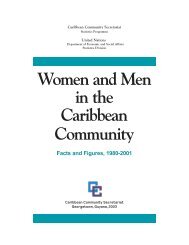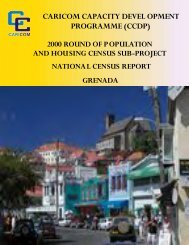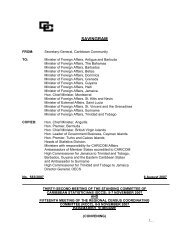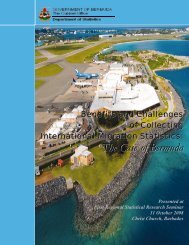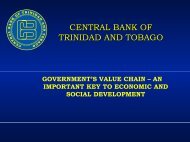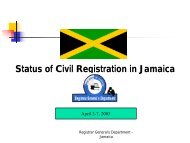CARICOM CAPACITY DEVELOPMENT PROGRAMME (CCDP)
CARICOM CAPACITY DEVELOPMENT PROGRAMME (CCDP)
CARICOM CAPACITY DEVELOPMENT PROGRAMME (CCDP)
Create successful ePaper yourself
Turn your PDF publications into a flip-book with our unique Google optimized e-Paper software.
National Census Report 2001, St. Vincent and the GrenadinesIn 2001, 480 persons were in the Sixth Form Community College, 838 in Technical College and528 were at University (Table 4.5). These figures represent an increase in post secondaryeducation compared to 1991. Kingstown and Calliaqua, compared to the other administrativedivisions, had the highest percentage of students that attended post-secondary institutions, 10.91and 10.31 per cent respectively.There were more females than males that attended post secondary school, 60 males for every 100females. The sex difference was even more pronounced in Kingstown, which had the secondhighest number of students at this level compared to the other administrative divisions. In thisdivision, the females that attended post-secondary school outnumbered the males two to one.Although education is free at the Community College, only a small number of persons haveaccessed this level of education. Kingstown and Calliaqua together accounted for 250 of the 480students that attended Sixth Form Community College. This is mainly because there is only onecampus, which is located in Kingstown, which makes access much easier for those living thereand the surrounding environs. Cost is one factor that could explain this low level of attendance atcommunity colleges. The cost of commuting from other parts of the country or boarding is veryhigh and limits accessibility. Those living farthest away in Sandy Bay and North and SouthGrenadines had the lowest percentages of persons that attended a post secondary school, 2.40,2.80 and 3.00 per cent respectively.4.3.4 Special Education 9Less than one per cent of the population that attended school was in special education. Theynumbered 106 and were mainly from Calliaqua (23), Kingstown (18) and Kingstown Suburb(18) and North Grenadines (15), (Table 4.5). There were more females (59) than males (47) inthe special education programmes. These figures are relatively low when compared to theaccepted rate of 10 per cent of the total population that require special needs. It is suspected thatmany of the children with special needs have no or limited access to special education.9 No Table was provided by the writer.47



